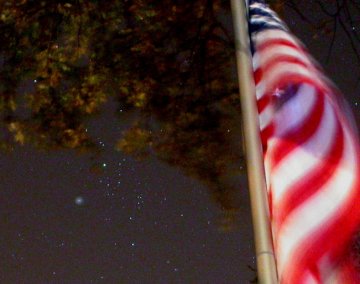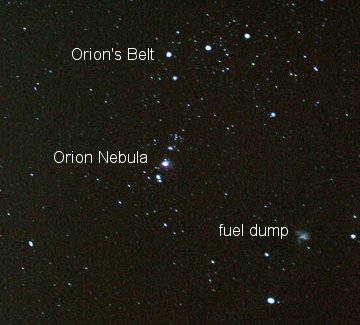 Where's Saturn? Is that a UFO--or the ISS? What's the name of that star? Get the answers from mySKY--a fun new astronomy helper from Meade. Where's Saturn? Is that a UFO--or the ISS? What's the name of that star? Get the answers from mySKY--a fun new astronomy helper from Meade. TAURID METEORS: The annual Nouthern Taurid meteor shower caused by Comet Encke is underway. Although Taurid rates are normally low, only about five meteors per hour, those five can be doozies. The shower is a well-known producer of terrestrial fireballs and lunar explosions. Taurids can appear at any hour of the night, so be alert for meteors this weekend: sky map. COMET 17P/HOLMES: Twenty-seven seconds. That's all the time you need to capture a nice picture of Comet 17P/Holmes. Last Friday night, Tom Wagner of Waterloo, Iowa, pointed his Nikon Coolpix 4500 at Perseus, opened the shutter for 27 seconds (ISO 400) and--voila!--an exploding comet: 
"I am amazed at how bright Comet Holmes is," he says. "I've driven around town showing my relatives and students this awesome sight." Comet 17P/Holmes is definitely worth watching. On Oct. 24th the comet exploded, brightening a million-fold to naked eye visibility. It has since expanded almost as large as a full Moon while dimming only slightly. And on Nov. 8th, astronomers watched in amazement as the comet's tail broke off! Got a telescope? Monitoring is encouraged: sky map, ephemeris. 3D BONUS: Grab your 3D glasses. Graphic artist Patrick Vantuyne has combined two photos of Comet Holmes, one taken by Jack Newton in Arizona and one by Ivan Eder in Hungary, to create an eye-popping stereo portrait: stereo image. "The stereo effect has nothing to do with the different locations of the photographers," he notes. "It is a result of the movement of the comet among between the two pictures." Comet 17P/Holmes Photo Gallery
[Interactive World Map of Comet Photos]
[sky map] [ephemeris] [3D orbit] [Night Sky Cameras]
FUEL DUMP: During the weekend, sky watchers noticed a new nebula in the constellation Orion. "It looked similar to the Andromeda galaxy--then, it began growing larger and we realized it was moving fast," reports Anna Webb of Hawaii. "Is this a new comet? A satellite burning up in the atmosphere?" Answer: It was a rocket fuel dump. Pierre Martin of Ottawa, Canada, photographed the event using his Canon 30D: 
"Saturday night (Nov. 10) at 8:50 pm EST, a Delta-4 Heavy Rocket was launched from Cape Canaveral, Florida," says Martin. "The payload was a Defense Support Program missile warning satellite (DSP-23). A circularization burn for the DPS-23 was scheduled for 3:01am EST, followed by a fuel dump at 3:21 am EST. Because both the Centaur rocket burn (duration: 3 minutes) and the residual fuel and oxidizer dump after payload separation occurred at an altitude of 22,000-miles, both were briefly visible to the naked eye. Through binoculars, one of the expanding clouds looked strikingly like an angel." more images: from Jay Ballauer and Vance Bagwell of Crowell, Texas; from Thomas O'Brien in the Maroon Bells Wilderness near Aspen, Colorado. | 
